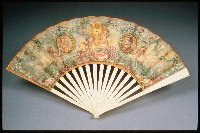


![]()

Fans Glorious Fans
May 29th to September 26, 2004
Collection of The John and Mable Ringling Museum of Art,
The State Art Museum of Florida
Fans are known to have existed as early as 3,200 B.C. in ancient Egypt, used by
servants to cool their God-Kings, in the scorching dry climate of the Egyptian
desert. But from the very beginning, fans have not only been used as useful
accessories, but also as symbols of status and works of art, their artistry as
varied as the craftsmen who made them. From Tutankhamen’s tomb, for example, came
a gold fan decorated with designs of the Pharaoh riding a royal chariot, that was
originally decorated with ostrich plumes. From Renaissance paintings and lists
of royal possessions we learn fascinating details of the tastes of the rich and
famous in the 16th and 17th centuries. Catherine de’ Medici (1519-89) had fans
with jewel encrusted gold and silver handles in her dowry at the time of her
marriage to King Henry II of France. Elizabeth I of England owned over two
dozen elaborately embroidered, feathered and lace fans; described among her
favorite belongings in the inventory compiled at the time of her death in 1603.
 Italian Late 18th Century Fan
Italian Late 18th Century Fan
The 18th century is considered the Golden Age of fan making, and many exquisite
examples have survived, a testament to the care that these delicate artworks have
always been accorded. In our exhibition the 18th handpainted silk fans, lace,
and gilded paper or kidskin leaf fans with pierced and decorated ivory and
tortoise shell sticks are typical of the beauty and elegance of the age,
inspired by the luxurious and exotic designs that flowed across Europe from
the extravagant Royal Court at Versailles.
 19th Century Italian Fan
19th Century Italian Fan
Fans were mass-produced by the second quarter of the 19th century and became affordable to the general public that had long regarded the trappings of the rich with envy. Here in the United States the inventor Edmund Soper Hunt was the first to develop a machine for folding fan leaves and gluing them to the sticks all in one process (1866). As a result, fans almost became regarded as commonplace articles, one more aspect of the industrialization of the period. Yet in spite of the success of the factory belt, many small workshops continued to create individualized fans by special order, and again looked to French designs with all their lighthearted appeal.As a cheaper alternative to handpainting, various types of prints such as etching, engraving, woodcut and lithography were incorporated touched up by hand with swift brushstrokes. Oriental lacquered fans became popular, often made entirely of sticks and decorated with Chinese Court Scenes and flowers.

19th Century French Fan
As the century drew to a close, souvenir fans became popular reminders of dream vacations or special occasions such as the dedication of the Eiffel Tower in 1889. Post impressionists jumped on the bandwagon, with Degas and Pissarro offering bold designs that focused on hot splashes of color, a far cry from traditional and painstaking decorations of the past.
 Princess Diana's Wedding Fan
Princess Diana's Wedding Fan
The 20th century is regarded as an age of the spectacular, with large ostrich plumes and sterling silver leading the fashions, as shown in the star of this exhibition: a fan created to commemorate the wedding of the lovely Lady Diana Spencer to Charles Prince of Wales. Only twenty five such fans were created for this outstanding British Royal occasion and of those, three are here in the United States. That the fan collection at the John and Mable Ringling Museum of Art contains one of the three, exemplifies the rarity and quality of its fan collection as a whole.